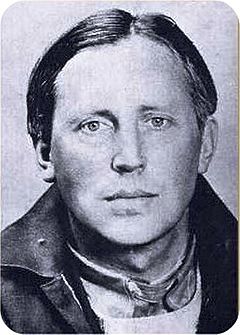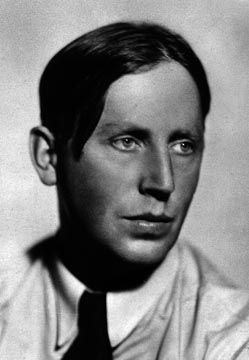<Back to Index>
- Jurist Carlos Saavedra Lamas, 1878
- Writer Johan Nordahl Brun Grieg, 1902
- President of Nicaragua José Santos Zelaya López, 1853
PAGE SPONSOR


Johan Nordahl Brun Grieg, known as Nordahl Grieg, (1 November 1902 – 2 December 1943) was a Norwegian poet, novelist, dramatist, and journalist.
Born in Bergen, Norway, he made his debut in 1922 with Omkring Kap det gode Haab (Around the Cape of Good Hope), which was followed by Skibet gaar videre (The Ship Sails On) in 1924.
Grieg spent 1927 as a newspaper correspondent in China, where he witnessed first hand the civil war between the Kuomintang and the Communists. The same year saw the production of Grieg's plays En ung manns Kjaerlighet (A Young Man's Love) and Barabbas.
In 1936, Grieg established the magazine Veien Frem, which would become notable as an anti-fascist forum.
Grieg, himself known as an anti-fascist and pro-communist writer who had studied the techniques of Soviet stage and film while in the Soviet Union, committed himself toward the struggle against the occupation following the German invasion of Norway. In his early resistance against the German occupation he parted from the Norwegian communists, as they mostly were passive until Nazi Germany invaded the Soviet Union.
In 1940, he escaped to England in the same vessel carrying the Norwegian Royal family and the National Gold reserves.
Once in Britain, Grieg served in Norway's government - in - exile and participated in making patriotic radio programs in England. He was commissioned into the Norwegian Armed Forces and served as a war correspondent. At the time of his death he was a Captain. His work involved visiting Norwegian units around Britain and experiencing their duties, in order to make his reports. He also travelled outside Great Britain to meet Norwegian servicemen on duty in Iceland and other more remote outposts. In the summer of 1942 Grieg spent several weeks on the Norwegian island of Jan Mayen in the Atlantic Ocean, writing the poem Øya i Ishavet (English: The Island in the Ice Sea). Like other war correspondents he joined operational missions over occupied Europe, and it was in the course of one of these that he lost his life.
On the night of 2-3 December 1943, Captain Grieg was attached to 460 Squadron, an Australian squadron based at Binbrook, as one of several observers for a raid on Berlin. Grieg joined the crew of a Lancaster Mk.III, serial number LM.316 and letter codes "AR-H2", captained by Flying Officer A.R. Mitchell, RAAF. Berlin was always a tough target as it was the capital city and so was well defended, but also because it lay far in the east of the country, which meant that crews were not only flying on the limits of fuel and of their own endurance, but had to pass over many night fighter bases on the way to the target, and all the way back home again. 460 Sqn. lost five aircraft that night and one of them was Lancaster LM.316. 37 airmen had been on board these aircraft and only eight survived being shot down, to spend the rest of the war in a POW camp. None of the eight survivors came from aircraft LM.316. So, in addition to the distinguished Norwegian supernumerary, all seven crew members: four Australians and three Britons, went down with the aircraft. Grieg was neither the only war correspondent shot down that night, nor the only Norwegian. An Australian correspondent also flying with 460 Sqn. was killed, and a British correspondent with another squadron became a POW. Among the 44 'RAF' aircraft and nearly 300 aircrew lost on this single raid were two Norwegians in a Halifax that was part of the elite Pathfinder Force (PFF). The captain of this Halifax was a Norwegian Lieutenant who managed to maintain control long enough to allow his compatriot, and all five British members of the crew, to bail out successfully and become prisoners of war, at the cost of his own life. For a population as small as that of Norway, the attrition of losses such as this on each raid was quite significant, but the loss of a figure as famous as the poet Nordahl Grieg was the extra blow on this night.
After the war, Grieg became a hero in Norway because of his resistance to the German occupation, both during the invasion itself and in the continuation of the fight in the forces in exile in Britain. Grieg is still popular in Norway today, especially his anti-fascist poetry. A statue of him created by Roar Bjorg, is now placed at the east side of the theatre in Bergen.
Nordahl Grieg is related to the famous composer Edvard Grieg, and brother of the powerful Norwegian publisher Harald Grieg.